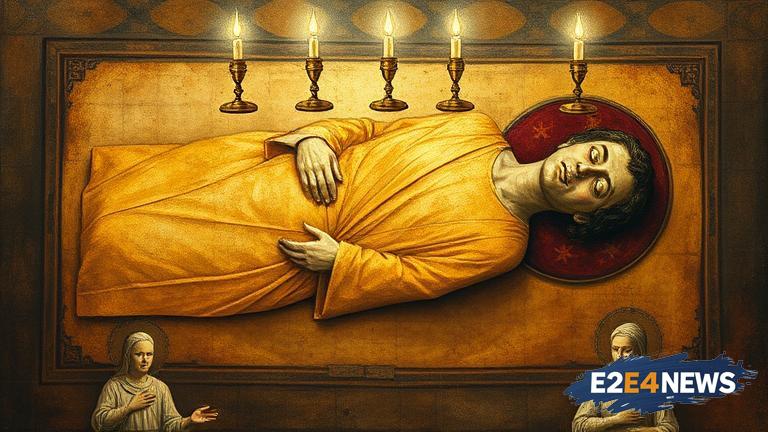The Shroud of Turin is a piece of cloth measuring 14 feet 3 inches long by 3 feet 7 inches wide, made of linen, and bearing the image of a man who has been crucified. The shroud has been the subject of intense debate and research, with many questioning its authenticity and origins. Some believe it to be the actual burial cloth of Jesus Christ, while others consider it a medieval forgery or an artistic creation. The shroud is currently housed in the Cathedral of Saint John the Baptist in Turin, Italy, where it is displayed to the public on rare occasions. The image on the shroud is that of a man who has been brutally beaten, scourged, and crucified, with wounds consistent with the biblical account of the crucifixion of Jesus. The shroud also bears the image of a face, which many believe to be that of Jesus. The history of the shroud is shrouded in mystery, with the first recorded mention of it dating back to the 14th century. It is believed to have been in the possession of the House of Savoy, the ruling family of Italy, before being transferred to the Cathedral of Saint John the Baptist. Over the years, the shroud has undergone numerous tests and examinations, including radiocarbon dating, which has yielded conflicting results. Some scientists have dated the shroud to the Middle Ages, while others have argued that the dating is flawed and that the shroud could be much older. The shroud has also been the subject of extensive artistic and historical analysis, with many experts believing it to be a masterpiece of medieval art. The image on the shroud is remarkably detailed, with some experts arguing that it could not have been created using the techniques available during the Middle Ages. The shroud has also been the subject of numerous books, articles, and documentaries, with many exploring its history, significance, and cultural impact. Despite the many theories and debates surrounding the shroud, its true origins and meaning remain a mystery. The shroud continues to be a source of fascination and inspiration for people around the world, with many regarding it as a powerful symbol of faith and spirituality. The shroud has also been the subject of extensive scientific research, with many experts seeking to unlock its secrets and understand its significance. The shroud is a remarkable example of the intersection of art, history, and science, and its study continues to be an active area of research and debate. The shroud has also been the subject of numerous exhibitions and displays, with many museums and galleries showcasing its image and history. The shroud is a cultural icon, with its image being reproduced and referenced in countless works of art, literature, and film. The shroud continues to be a source of inspiration and fascination for people around the world, with its mystery and significance continuing to captivate audiences. The shroud is a reminder of the power of art and history to inspire and educate, and its study continues to be an important area of research and exploration.





